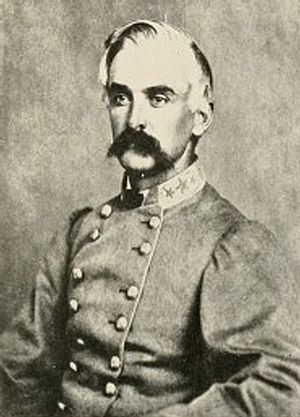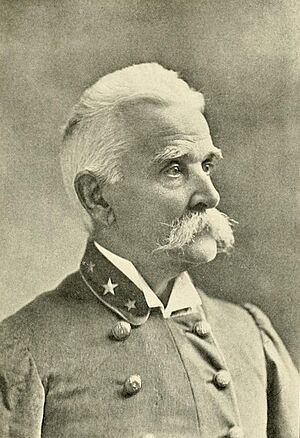Thomas T. Munford facts for kids
Quick facts for kids
Thomas T. Munford
|
|
|---|---|

Confederate Cavalry General Thomas T. Munford
|
|
| Born | March 29, 1831 Richmond, Virginia |
| Died | February 27, 1918 (aged 86) Uniontown, Alabama |
| Place of burial | |
| Allegiance | |
| Service/ |
|
| Years of service | 1861–1865 |
| Rank | (Acting) Brigadier General (not confirmed by congress) |
| Commands held | 2nd Virginia Cavalry Munford's Cavalry Brigade Fitzhugh Lee's Cavalry Division |
| Battles/wars | American Civil War |
| Other work | planter, manufacturer, writer |
Thomas Taylor Munford (March 29, 1831 – February 27, 1918) was an American soldier and businessman. He served as a high-ranking officer, a colonel, in the Confederate Army during the American Civil War. After the war, he became a successful farmer and worked in the iron and steel industry.
Contents
Who Was Thomas T. Munford?
Early Life and Education
Thomas T. Munford was born in Richmond, Virginia. His parents were Colonel George Wythe Munford and Lucy Singleton Taylor.
In 1849, when he was 18, Munford enrolled at the Virginia Military Institute (VMI). He studied there for three years and graduated in July 1852. He was 14th in a class of 24 students.
In 1853, he married Elizabeth Henrietta Tayloe. Before the Civil War began, Munford worked as a cotton planter in Mississippi. He also farmed in Bedford County, Virginia.
Joining the Civil War
When the American Civil War started, Munford joined the Confederate States Army. He officially became a soldier on May 8, 1861. He started as a lieutenant colonel in the 30th Virginia Volunteer Regiment. This was a mounted infantry unit, meaning soldiers rode horses but fought on foot.
His unit fought in the First Battle of Bull Run, also known as the First Battle of Manassas. Later, the cavalry (soldiers on horseback) was reorganized. Munford was promoted to colonel and given command of the 2nd Virginia Cavalry.
Key Battles and Commands
During the 1862 Jackson's Valley Campaign in the Shenandoah Valley, Munford served under General Stonewall Jackson. He commanded a cavalry brigade, which is a group of military units. After Colonel Turner Ashby died, Munford took over command of all of Jackson's cavalry.
He fought well at the Battle of Cross Keys. His troops also captured many prisoners near Harrisonburg, Virginia. During the Peninsula Campaign, he led his men at the Battle of White Oak Swamp.
Munford also played an important role in the Second Manassas Campaign. He was slightly wounded at Turkey Run Bridge. His troops also fought in the Second Battle of Bull Run.
In the Maryland Campaign, Munford was temporarily given his own command. He successfully cleared Union forces from Leesburg, Virginia. This allowed the Confederate army to cross the Potomac River. He also led his troops in a key defensive position at the Battle of South Mountain. His men saw limited action at the Battle of Antietam.
In 1863, his cavalry participated in several battles during the Gettysburg Campaign. They also fought in the Bristoe Campaign. In 1864, they were part of cavalry actions in the Overland Campaign under Major General Fitzhugh Lee.
Later War Service
On November 9, 1864, Fitzhugh Lee appointed Munford to serve as a brigadier commander. Although he was often called a general, he was never officially confirmed as a brigadier general by the Confederate Congress.
Late in the war, Munford took command of Fitzhugh Lee's cavalry division. This happened when Lee was promoted to lead the entire cavalry corps. Munford's troops fought in important battles like Five Forks, High Bridge, and Sailor's Creek.
Before General Robert E. Lee surrendered at Appomattox Court House, Munford led his men away from the main Confederate army. His goal was to reach North Carolina and join General Joseph E. Johnston's army. However, when he heard that Johnston had also surrendered, Munford disbanded his forces after reaching Lynchburg, Virginia.
Life After the War
Munford's first wife died in 1863. In 1866, he married her cousin, Emma Tayloe.
After the war, Munford inherited a large farm called Oakland in Perry County, Alabama. He worked there as a cotton planter. Later, he returned to Virginia. There, he continued to work as a cotton planter. He also became involved in the iron manufacturing business and worked as a writer.
He served as the Vice President of the Lynchburg Iron, Steel & Mining Company. From 1884 to 1888, he was the President of the Virginia Military Institute Board of Visitors. This board helps oversee the school.
Thomas T. Munford passed away on February 27, 1918, at the age of 86. He died at his son's home in Uniontown, Alabama. He was buried at Spring Hill Cemetery in Lynchburg, Virginia.


